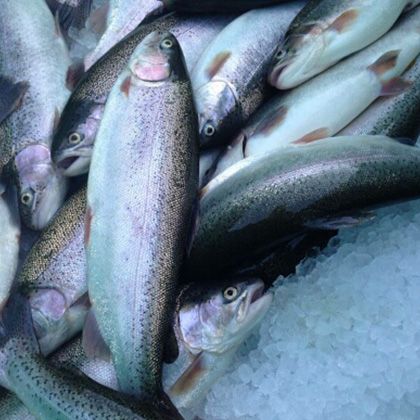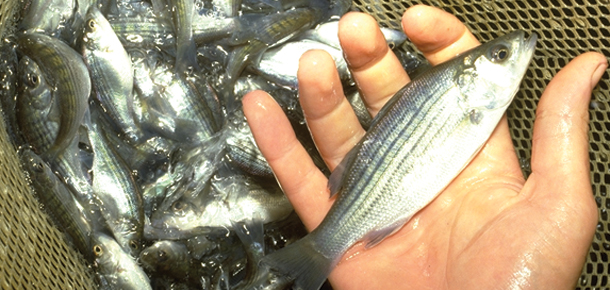
|
||||||
| Fisheries :: Culture Fisheries | ||||||
FIN FISHES
Some species mainly car- nivores require grading (removal of shooter fish) in every 3-4 days to reduce cannibalism. The sur- vival rate in the nursery phase can be up to 90 % in 30-45 days of rearing. Hapa should be checked and cleaned regularly. The fry on reaching a size of 25-40 g at the end of another 30-45 days can be stocked in the open sea cages for the grow- out system. The survival rate for the nursery pe- riod would be 50 to 80 %. This would depend on feeding, environmental conditions, and the skill of the fish farmers. Grading of fry and transport of juveniles: Due to cannibalistic nature, for fish like seabass, size selection or grading or sorting of the fry is impor- tant Grading is initiated while in the hatchery it- self at around 12-15 days old, and done every 3-5 days. Mechanical or manual grading is followed. Different types of graders fixed as well as adjust- able types are now available in the international market. Since the number of fishes in the tanks as well as in the hapa is high, the competition for feeding increases and the fittest will only get the feed and this makes it essential to grade the fish more frequently. For Asian seabass grading is es- sential at least till the fish reach 30-40 g, which is ideal for stocking in grow-out cages. Fingerlings of 25-30 g or even more are starved 2-3 hours prior to transportation to grow-out sys- tems. If the salinity of grow out is different, the fishes are acclimatized to the same salinity prior to transportation and if required minor sedation can be provided for bigger fishes. Stocking density and production The stocking densities of species in cages are highly variable and the optimum density for many species is not known. Stocking in cages can be high density/ low volume or low density/ high volume. Low density/ high volume stocking (2-20 fish/m3) are recommended for species like Cobia for which harvest size is several kilograms; high density/ low volume stocking (50-250 nos/m3) are good for those fishes target harvest is 1 kg or less. The number of fish to be stocked also depends on the carrying capacity of the cages. The stocking in a cage is done keeping in mind the production target in the open water. The ideal stocking is to produce 25 kg/m3. However, there were several instances where production was enhanced to 100 kg/m3 in open sea cages. Optimal stocking rate ensures optimum yield at the end of the culture period as food conversion, survival rate, and con- dition of the cultured fish are closely related. The smallest recommended fingerling size for stock- ing is 15 g. A 15 g fish will be retained by a 13 mm mesh net. Survival rates in well-placed and well-managed cages are typically 98 to 100%. Optimal stocking rate varies with species, feeding behavior and environmental characteristics. Feed and feeding For aquaculture, the most important factor is feed and feeding. A cost- effective feed of good quality and acceptance determines the produc- tion in any culture system. The nutritional re- quirement is dependent on the cultured species and its stage of development. Young fish are fed with high protein diet which is reduced with age. Carnivores like seabass and cobia are fed with high protein diet all through the culture duration. To arrive at a cost effective diet the nutritional re- quirements of the species has to be known and accordingly the feed has to be formulated. Feed- ing is a vital operational function and may include many biological, climatic, water quality, and eco- nomic considerations. The direct influence on growth rate in terms of feeding intensity, feeding time, food rations are important economic consid- erations a farm operator has to make. The feeding characteristics of each species vary in maximum feed intake, digestion, feeding frequency and con- version efficiency. These in turn have direct ef- fects on the net-yield, survival rates, size of fish and the overall production. Cage management The growth and thereafter production can be regulated through proper management of the various culture activities. The major factors to be taken care in cage management are:
Feed management Feed and the feeding regimes need proper management for better health and growth of the cultured stock. However, the quality and safety of feed and the use of fish medicines and chemicals must be controlled by concerned agencies so that it will integrate aquatic product security examina- tion, environmental monitoring and fish disease prophylactic systems at different levels (Imelda- Joseph, 2009). Storage facilities are essential for cage fish farming operations. Feed bags should be stored without open access to moisture to pre- vent fungal attack. Trash fish may arrive at the farm in either frozen or unfrozen state and since fish spoils rapidly it should be checked for fresh- ness before being stored. Smell and appearance should be sufficient indicators of quality. Cold storage is ideal for trash fish. Feeding should be done throughout the culture period at varying lev- els depending on the growth rate and natural feed availability. Hand feeding is done in most cases and is recommended for small scale farmers. However, mechanical feeders are used in large scale cage farms- demand feeders and automatic feeders are the two types of feeders used. Feeding trays or feeding rings can be used based on the type of feed used. Water quality management Routine monitoring of water quality is essential
Waste control and effluent management Cage-farm wastes are usually in the form of un- eaten feed and faeces. Feeding should be sched- uled in such a way to ensure that feed wastage is kept to a minimum. Use of floating feed is vital for cage-farm operations. Mooring cages in deep wa- ters, leaving 3-5 m bottom space and where good current flow results in cage wastes being easily flushed away, thereby avoiding organic build up under the cages. Health management practices Health management is essential to maintain a good health status, assuring optimum produc- tivity and the avoidance of diseases. In aquacul- ture, the economic risk associated with diseases is high and represents a potential loss in production through mortality and morbidity. Moreover, the cost to treat diseases when they are already well established is high and treatments are often ini- tiated too late and are therefore rarely effective. Thus, aquatic animal health management must be a global strategy that aims to prevent diseases be- fore they occur. Aspects of fish health management
Maintenance of cages and gear Irrespective of the damage that can be caused by storms, predators, drifting objects, poachers, all materials used in construction of cages have a definite life span and will eventually wear out. Cages, nets and moorings therefore must be checked at intervals for signs of damage and wear and tear and repaired or replaced if necessary, as not only cages and stock be put at risk, through neglect, but human life may also be endangered. Mooring must be checked regularly by divers, particularly after heavy wind/storms. Mooring level should be kept free from fouling and worn shackles replaced. Cage nets may be checked during cleaning, which is done more frequently during cage cul- ture. Divers may have to go down and observe the net every week or so, during favourable weather conditions. Small tears may be repaired at the site itself, while major repairs should be done on shore only. Net exchange has to be done periodi- cally to avoid fouling constraints and good water exchange. In marine environment fouling is a major issue and in rotating design (single point mooring sys- tem) it is reduced. Therefore, the nets have to be frequently changed. In any case, nets of any par- ticular mesh size should be exchanged quite often for ones with larger size as the fish grow. Mesh size should be carefully selected at each stage of growth too. If too small mesh size is selected, then matter exchange is restricted and if too large, escape is possible. The frequency of net change varies from once in a week to once in a year de- pending upon the site location, materials used, season and management and design of cage. Net cleaning can be done physically or by chemical treatment. Physical cleaning involves removing and scrubbing the net and drying. For chemical cleaning bleaching powder or formic acid (3%) can be used. The rate of bio-fouling on cage frame is much slower than on net cages, and doesn't need more frequent cleaning. Cage frames are usually cleaned in situ using a hand brush both above and below the water line to dis- lodge weed and accumulated debris. Source : Grow-out culture of finfishes and management of marine cages |
||||||
© TNAU 2008-2024 All Rights Reserved. |
||||||

